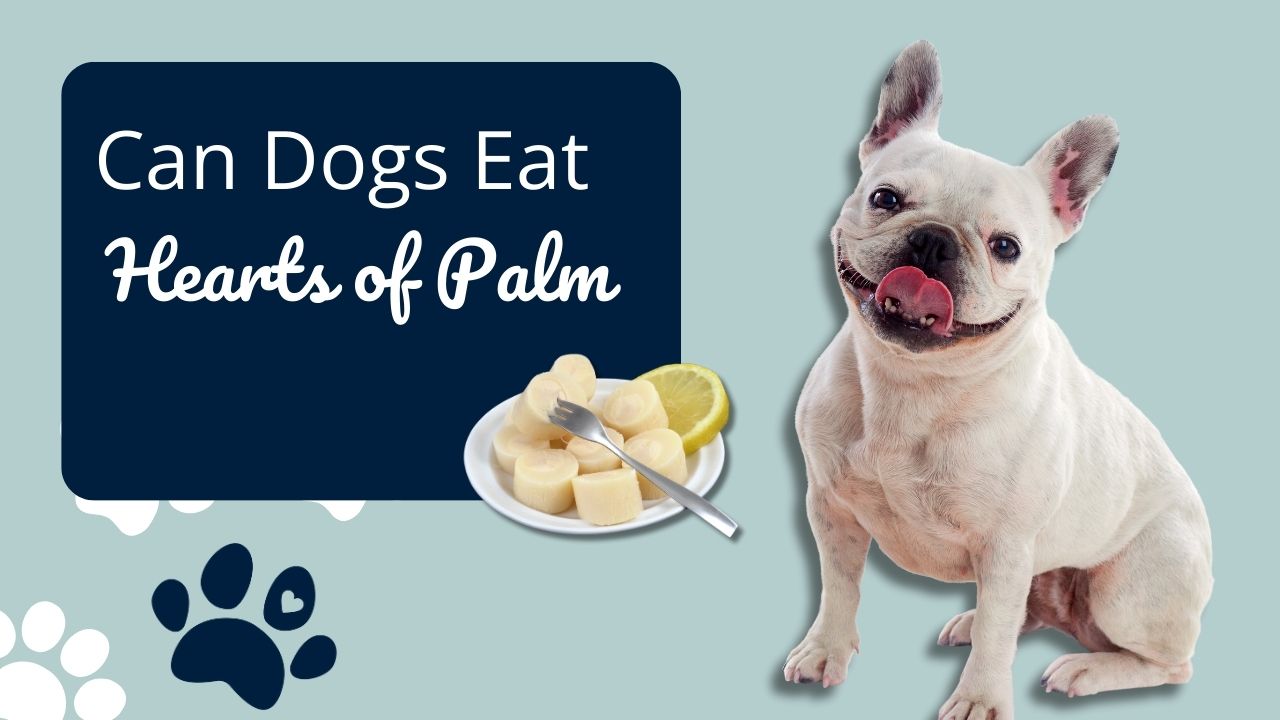Hearts of palm are a vegetable harvested from the inner core and shoots of various palm trees. Their taste is described as a cross between asparagus and artichoke hearts. As a nutritious and palatable vegetable for humans, some dog owners wonder if hearts of palm are also safe for their canine companions. The short answer is yes, dogs can eat hearts of palm in moderation.
Since they contain insoluble fiber, feeding dogs a few bites of hearts of palm can aid digestion. However, moderation is key as too much fiber can cause gastrointestinal upset. Hearts of palm should always be fed to dogs raw, never cooked or canned, as the high sodium content found in processed versions can be unhealthy. Read on to learn more about the benefits and potential downsides of feeding hearts of palm to dogs.
What are Hearts of Palm?
Hearts of palm are the soft, edible inner core and shoots of various types of palm trees. They have a white, dense, slightly crunchy texture that has been compared to that of artichoke hearts or swamp cabbage. The most common varieties are the peach and palmetto palms.
To obtain hearts of palm, the tree’s top shoot is cut off, allowing the tender inner section of the trunk to be extracted. After harvest, the outer layers and fibers are removed and the hearts are prepared by peeling, cutting, and canning or vacuum sealing.
The hearts of palm have a subtle flavor and are highly versatile. They are most popular in salads but are also commonly sauteed or used in soups, stews, stir-fries, and dips like hummus. Canned hearts of palm are available year-round and make a nutritious, low-calorie addition to many dishes.

Nutritional Value of Hearts of Palm
Hearts of palm are packed with nutrients that can benefit both humans and canines. Some of the key vitamins and minerals in the hearts of palm include fiber, potassium, magnesium, zinc, vitamins A and C, thiamin, folate, and iron.
The high fiber content aids digestion which is helpful for dogs prone to constipation or diarrhea. Potassium is an electrolyte that supports nerve signaling and a healthy heart. Magnesium is involved in over 300 enzyme systems in the body and helps maintain muscle and nerve function. Other nutrients like vitamins A and C have antioxidant properties to boost immunity.
Compared to other common dog-safe veggies like carrots and green beans, hearts of palm have slightly higher levels of key nutrients by weight. For example, a 100-gram serving contains 7.6 grams of fiber compared to 2.8 grams of carrots and 4.3 grams of green beans. They also supply more vitamin C, folate, iron, and other vitamins and minerals.
Overall, incorporating some hearts of palm into a balanced raw or cooked homemade dog food diet provides additional health benefits from key nutrients and fiber with low calories. Learn natural ways to beef up your dog. As with any human food, moderation is key when feeding to avoid gastrointestinal issues.
Safety and Potential Risks of Hearts of Palm for Dogs
The good news is that hearts of palm are non-toxic for canine consumption. However, there are some potential risks to be aware of when feeding hearts of palm to dogs.
Since they contain a high amount of insoluble fiber, too much at once can lead to digestive issues like upset stomach, abdominal pain, gas, loose stools, or diarrhea. Small dog breeds may also find the fibrous pieces difficult to digest. Monitoring your dog’s stools and symptoms helps determine an appropriate portion size.
The somewhat crunchy, dense texture also poses a potential choking hazard if larger pieces are served. It is safest to cut hearts of palm into small, bite-sized pieces before feeding to dogs, especially smaller breeds or young puppies. Carefully supervise your dog when they are eating to prevent excessive gulping and choking.
While most healthy dogs can enjoy an occasional few bites of hearts of palm, each dog’s tolerance level can vary. To err on the side of caution, start by feeding your dog tiny portions of fresh hearts of palm at first. Pay attention to any vomiting, diarrhea, constipation, or signs of distress afterward to gauge if larger portions or increased feeding frequency is appropriate. Consulting your veterinarian provides helpful personalized advice as well. Learn why your puppy not eating much and sleeping a lot.
Serving Hearts of Palm to Dogs
When serving Hearts of Palm to your dog, proper preparation is key. The fibrous texture lends well to chopping or shredding into bite-size pieces. Lightly cooking or blanching can also soften them up for easier eating and digestibility.
You can incorporate tiny shredded bits of hearts of palm into wholesome homemade dog food recipes containing rice, chicken, vegetables, and broth. The subtle flavor complements many dishes. Plain-boiled chicken or rice mixed with a few chopped hearts of palm also makes a simple meal topping or snack.
Since tolerances vary amongst dogs, start by offering just a teaspoon worth of hearts of palm at first. Gradually increase to a tablespoon or two if your dog enjoys them without issue. Less active or smaller breed dogs likely require much smaller portions than larger, active breeds.
Some dogs may not take to the unique vegetable flavor right away. Alternatives like chopped sweet potatoes, cored apple slices, or shelled peas make nutritious alternatives to try instead. With patience and positivity, you may find your furry friend acquires the taste after repeated moderate exposure. Monitoring stool health remains important in the process.
The key is introducing hearts of palms slowly and gauging your individual dog’s reaction. Patience coupled with caution helps ensure your dog can reap the benefits safely.
Conclusion
In summary, introducing some fresh hearts of palm in moderation to your dog’s diet can provide nutritional benefits, thanks to ample fiber and key vitamins and minerals these vegetables contain. Their mild, subtly sweet flavor makes them a tasty addition to many homemade dog food recipes as well.
However, hearts of palm do carry some risks such as choking hazards or gastrointestinal upset if excess portions are consumed by dogs not accustomed to digesting their fibrous texture. Starting slowly with tiny amounts chopped finely and monitoring stool health and reactions allows dog owners to find their pet’s tolerance level.
As with incorporating any new human foods, consult your veterinarian first if you have concerns. Work with them to determine an appropriate serving size tailored to your dog’s size, breed, age, and medical conditions. Report any adverse reactions right away. Remember that each pet has their own unique needs, so what one dog thrives on may cause issues for another. With smart moderation and attentive supervision, most canines can benefit from an occasional helping of hearts of palm as part of a balanced, nutritious homemade diet.
FAQs
Can dogs eat hearts of palm raw?
Yes, dogs can safely eat fresh, raw hearts of palm in moderation. Raw hearts have not been processed or packed with preservatives and sodium like canned versions. Make sure any raw vegetables are thoroughly washed before serving. The raw fibrous texture may be easier for some dogs to digest as well.
Are all varieties of hearts of palm safe for dogs?
The most common, safest varieties are peach palms and palmetto palms. Avoid sabal palm hearts of palm as they have been related to acute gastrointestinal issues. Only offer your dog fresh or frozen raw hearts, not canned, pickled, or pre-marinated versions which likely contain seasonings and additives unhealthy for dogs.
Can I use Hearts of Palm as a training treat for my dog?
Chopped or shredded bits of the heart of palm can serve as low-calorie training treats in tiny portions. Their mild taste appeals to some dogs. However, their high fiber content means excess treats might disrupt your dog’s digestive tract. Monitor stool health closely. Also, the vegetable’s moisture content means pieces may break apart, making training sessions messy. More traditional baked or freeze-dried treats with less fiber tend to work best for most training purposes.
Are hearts of palm poisonous to dogs?
No, hearts of palm from common palm varieties like peach palms and palmetto palms are not poisonous to dogs. Both the vegetable’s flesh and the shoots are non-toxic for dogs to eat in moderation.
Is palm good for dogs?
The fleshy part of the palm, known as the heart or palm cabbage, can be safe and nutritious for dogs when raw. However, dogs should not chew on or ingest other parts of a palm tree, like the fronds, branches, and seeds, as they may splinter, and cause blockages or digestive issues.
Is palm fruit toxic to dogs?
The plum-like fruit of palms, like coconuts, acai berries, dates, and açaí berries, are not poisonous but high in calories. Large amounts could lead to upset stomach, diarrhea, or weight gain in dogs.
Are palm seeds toxic to dogs?
The pit or seed inside palm fruits contains cyanide compounds that are released when chewed or damaged. Swallowing cracked or split seeds can be extremely toxic and fatal. Prevent dogs from accessing palm fruits with exposed seeds.
Can dogs chew on palms?
Dogs should not chew on any part of a palm tree, like the trunk, leaves, branches, or bark, which can splinter and lodge in their teeth, gums, or digestive tract. The sharp points also pose dangers. Provide safe chew toys instead.
What happens if a dog eats palm leaves?
While not poisonous, eating palm leaves or fronds can cause oral pain, obstruction, or internal damage for dogs. The stiff points and fibers are not easily digested and can cause distress. Seek emergency veterinary care if your dog swallows any amount of a palm leaf.
Monitor your dog closely whenever palm trees are accessible to prevent chewing and ingestion of non-edible parts. Only feed the soft edible vegetable heart, in moderation. Seek immediate vet care for signs of poisoning or gastrointestinal obstruction after palm exposure.
Additional Resources
Puppy With An Umbilical Hernia
Is my male dog affected by my period







